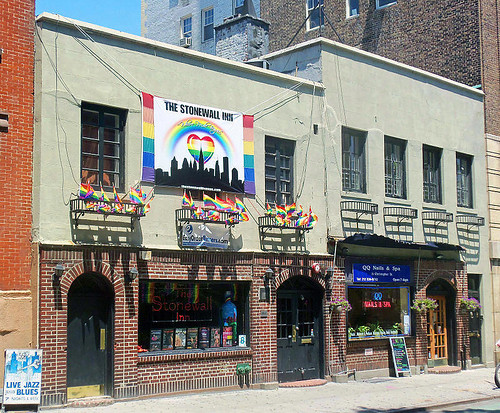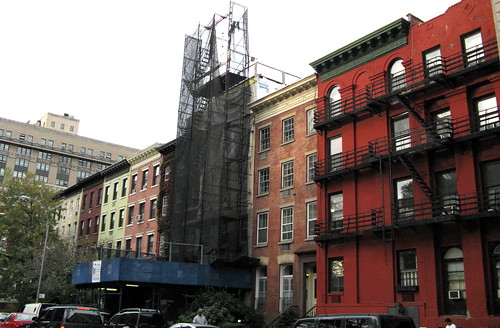If you ever for a moment doubt the importance of declaring a site as a landmark, preserving at least some part of it, or placing a sign at a spot of historical significance, go to The Stonewall Inn this month, in New York’s Greenwich Village. There, hundreds have converged in vigils and left remembrances such as flowers, after a gunman opened fire early Sunday morning, June 12, at Pulse, an LGBT nightclub in Orlando, murdering 49 innocent souls and injuring 53 others. Places imbued with meaning from the past continue to maintain a powerful pull in the present.
The Stonewall Inn, in the days since this horrible massacre, has been a peaceful place, drawing throngs of gay, lesbian, bisexual, and transgender people and supporters. Its role at times of celebration and grief personifies the power a place holds when history occurs there and as it continues to represent meaning, a haven, or presence for subsequent generations. There, one can reflect that in 1969, law enforcement targeted gay people for arrest and harassment, while in Orlando earlier this month, police risked their lives to stop the violence of a shooter armed with assault weapons to kill many, many people.
Historical places show us how far we have advanced as well as the deep fissures and obstacles that still exist. We live in a different, better world, we might say. Yet in some moments, we question how different.
Unfortunately, too many neglect the history and either do not know or grasp its significance – how others have endured death, wounds, emotional scars, jailing, and both setbacks and victories in various places across the land to win what some take for granted today. We need to be vigilant about that history, about all of its painstaking, brutal, hard-won steps.
These thoughts come to mind at various times, reflecting on whether those in subsequent generations grasp the magnitude of what another has accomplished or the significance of someone breaking a barrier to freedom and opportunity. Friends remarked that to some younger women and girls in their circle, it didn’t seem like a big deal that Hillary Clinton became the first woman to earn the nomination of a major political party for President. Yet, not very long ago, women protested, were jailed and beaten, and suffered many setbacks to win a woman’s right to vote in the United States and elsewhere. Barriers remain, here and across the globe.
The horrible massacre of Sunday morning, June 12, in Orlando starkly reminded those who have dared to forget history. At Stonewall, many have gathered to mourn, to honor their brothers and sisters, to decry the hatred – to ultimately say, hell, no, we won’t go back. We won’t hide. We will stand against the hate and sickness that cut so many lives short.
It’s precisely what hundreds of gay men and women said on a June night in 1969, when they had enough of the regular raids that New York City police conducted at The Stonewall Inn, during which they arrested patrons as well as the managers and employees. On one night, June 28, 1969, the gay men and women did what they had not before. Instead of accepting the arrests and seeing the bar close temporarily, the customers chose resistance.
Tensions built and exploded that night. When police wagons didn’t arrive immediately, those at Stonewall refused to leave quickly and instead congregated in and around the tavern. Many others arrived on Christopher Street outside. A struggle ensued when a lesbian whom police handcuffed and took toward a police wagon resisted and an officer struck her with a billy club. The crowd erupted, attempting to overturn a police wagon and fighting the police. The uprising outside the Stonewall and on adjoining blocks erupted for another two nights.
Today: The Stonewall National Monument
At the time of the uprising, it was against the law for gay people to be served alcohol at clubs or to dance with one another, as The Stonewall Inn history recounts. The authorities regularly raided the inn and demanded those at the tavern to show identification. However, this time tensions spilled over. For three days, the uprising took place, as gay citizens signaled they would not accept police raids and would fight back. In 1969, the rough, uncharted way forward of subsequent decades lay ahead. In the years following, lesbians, gay men, bisexuals, and transgender people came out of the closet, protested, campaigned against barriers and for equality, and made tremendous progress, albeit through the toll of hurt and death, as during the early years of the AIDS epidemic. The advancements and show of visibility and love as couples and families have come against the continuing, strong forces of backlash, ignorance, hatred, and violence.
The disturbances that June nearly five decades ago became a turning point and helped launch the gay civil rights movement. Each June, thousands mark Gay Pride Month. Today, many thousands are gathering and marching in New York City, as they have elsewhere across the United States this month, to celebrate gay pride, progress, and freedom, and to come together at a time of mourning and urgency in the wake of the Orlando tragedy and other incidents of violence and hatred. The march ends near the Stonewall, at Christopher and Bleecker streets.
The Stonewall Inn
Photo Credit: Daniel Case
This week, the federal government accorded this iconic inn status as a national monument. On Friday, June 24, citing The Stonewall Inn’s significance as a renowned birthplace of the modern movement for equal rights for LGBT citizens, President Obama designated this place as the Stonewall National Monument. It is the first national monument in the United States for the gay rights movement. The 7.7-acre Stonewall National Monument is comprised of the inn, the adjacent Christopher Park, and the surrounding streets where the patrons and supporters in 1969 rose up against the authorities. It is already a designated New York City landmark.
Another Era, Another Haven
Some grasp this importance of a place through the generations while others don’t. Those who do so often wage away-from-the-spotlight, meticulous, dogged, and often-thankless work to designate and save the places for future generations. Two women, Julie Finch and Fern Luskin, have spearheaded and led a determined effort for some nine years to halt a building owner’s construction of a fifth-floor addition atop a landmarked New York City building that is a confirmed Underground Railroad Site. The dwelling, at 339 West 29th Street, was a safe haven for runaway slaves heading northward. Inhabited by the abolitionist and reformer Abigail Hopper Gibbons, her husband James Sloan Gibbons, and their family, the house is part of the landmarked Lamartine Historic District. This row of 12 homes, on West 29th Street between Eighth and Ninth avenues, has survived intact since the mid-19th century in Midtown Manhattan.
Recently, the Friends of the Hopper-Gibbons Underground Railroad Site held a rally and fundraiser to promote their campaign. In large part, the two women who started the initiative to protect and restore the Hopper Gibbons house’s integrity as a landmark have cited its importance in witnessing and teaching history.
The house was a safe haven for slaves fleeing to freedom. During the 1863 Draft Riots in New York, mobs targeted it, as an unruly crowd broke in, ransacked the house, and ultimately set a fire. Two of the Gibbons daughters, hiding in a nearby relatives’ home, raced across the roofs of the rowhouses to escape. The owner’s new addition obliterates that place on a building that New York City declared a landmark in 2009 as part of the Lamartine Historic District.
This dwelling was the home of Abigail Hopper Gibbons, an abolitionist. The roof is where some family members escaped to safety after a mob threatened and set fire to the house during the 1863 Draft Riots in New York City.
However, the fate of the alteration remains undecided. The owner must obtain an approval from the city Landmark Preservation Commission to continue work, or the commission could also order the owner to restore it to the former state, according to an article in Chelsea Now on the preservation group’s effort and rally.
We cannot freeze-frame every site that possesses historical meaning, but we can save, protect, and honor a significant number of places. Furthermore, we owe an immense debt to those in each generation who work hard to ensure such landmarks and sites survive for coming generations. Many places remain vital to their communities and to the world. Those who felt such grief and horror at the mass shooting that occurred earlier this month in the Orlando nightclub found at Stonewall a place of community, peace, and safety to come together and grieve the horrible act of violence.
History lives and teaches us about ourselves in the places that we save and hold dear.





Nice piece! The aftermath of the Pulse attack shows that the good in the people who respond is exponentially greater than the evil of those who cause these tragedies.
Thank you so much! That sense of the decency, goodness, and care in humanity can get lost at times like the Pulse attack. If anything, we need to keep it in mind and heart, and multiply it by words and actions in our own lives.
Gratefully,
Susan
Great article, Susan! It highlights two major examples of institutionalised injustice against our fellow people. As you said, it is a different, better world now, but there is still two much racism, sexism, and homophobia, and the Right Wingers all over the world are feeding off a general sense of nostalgia that things were “better before” to push their agenda further towards the mainstream and turn us all into a less tolerant society. We must fight against it or we will find ourselves in another different, much worse world.
Well-said, David!
It is so true that an ignorant kind of nostalgia and an appeal to fear are still so strong across the globe. That is why, as you know better than anyone, physical structures and historical designations can be powerful teachers about the actual events and the injustices.
I still marvel that this block of Midtown Manhattan has survived from the mid-1800s, as one key example. I’m struck every time I read anew — and look at that dwelling — envisioning how the Gibbons daughters escaped a seething, out-of-control mob, who was attacking their home, by fleeing across the rooftops!
Thank you!
Susan